Sample Discrimination Complaint Letter
Subject: Formal Discrimination Complaint
Dear [Recipient's Name],
I am writing this letter to formally lodge a complaint of discrimination that I have experienced in [describe the context or specific incident where discrimination occurred]. I believe that my rights have been violated, and it is important to bring this matter to your attention in order to seek resolution and prevent similar incidents in the future.
I am an [employee/tenant/customer/student, etc.] and have been a [length of association] with [company/organization name]. I have always endeavored to carry out my responsibilities diligently and contribute positively to the workplace/environment. However, I regret to inform you that I have been subjected to discrimination based on [protected characteristic(s) such as race, gender, age, religion, disability, etc.].
The specific incidents of discrimination that I have encountered include, but are not limited to:
1. [Describe the incident(s) in detail, including dates, locations, individuals involved, and any witnesses present.]
2. [Provide additional incidents, if applicable.]
These actions have created an intimidating and hostile work/learning/living environment for me, and I firmly believe they violate both company policies and federal/state laws prohibiting discrimination.
I would like to bring your attention to the relevant laws and policies that protect individuals from discrimination, such as [mention specific laws, regulations, or policies that are applicable in your jurisdiction]. These laws emphasize the importance of promoting equal opportunities and maintaining a respectful and inclusive environment for all individuals.
As a result of the discrimination I have faced, I have experienced [describe the impact on your emotional well-being, work performance, academic progress, or any other relevant effects]. Discrimination not only affects the targeted individual but also undermines the overall morale and productivity of the workplace/school environment.
I kindly request that you undertake a thorough investigation into these allegations, taking appropriate action to rectify the situation and prevent future occurrences of discrimination. I would appreciate being informed of the steps you plan to take to address this matter and ensure that all employees/students/customers are treated fairly and without bias.
Please note that I am open to resolving this issue amicably and constructively. If it would be helpful, I am willing to participate in mediation or any other conflict resolution process to find a satisfactory resolution. I trust in your commitment to fostering a discrimination-free environment and to upholding the values of equality and fairness.
I have attached any supporting documentation or evidence that may assist in your investigation of this matter. Please treat this complaint with the utmost confidentiality and sensitivity.
I expect a prompt response within [reasonable timeframe, e.g., 10 business days] acknowledging the receipt of this complaint and outlining the next steps in addressing this issue. Failure to respond or adequately address this complaint may leave me with no choice but to pursue legal remedies available to me.
Thank you for your attention to this serious matter. I believe that by working together, we can rectify the situation and create a more inclusive and respectful environment for everyone involved.
Sincerely,
[Your Name]
Formal Workplace Discrimination Complaint Letter
Dear [HR Manager/Recipient Name],
I am writing to formally lodge a complaint regarding discriminatory behavior I have experienced in the workplace. On [Date], [Colleague/Supervisor Name] made [describe behavior or comment], which I believe constitutes discrimination based on [race, gender, religion, age, disability, etc.].
This behavior has caused [describe impact on work, mental health, or professional environment]. I request a thorough investigation into this matter and appropriate corrective action to prevent future occurrences.
Please acknowledge receipt of this letter and inform me of the next steps in the complaint process.
Sincerely,
[Your Name]
[Position]
[Department]
Discrimination Complaint Email to HR
Hi [HR Name],
I am reaching out to report an incident of discriminatory behavior I experienced on [Date] by [Person Name]. The incident involved [brief description] and made me feel [impact/emotion].
I would like to request that this be investigated according to company policy and would appreciate guidance on the next steps.
Thank you,
[Your Name]
Provisional Discrimination Complaint Letter Pending Investigation
Dear [HR/Manager Name],
I am submitting this provisional complaint regarding suspected discriminatory behavior by [Name] on [Date]. While I am gathering further details, I wanted to notify the company immediately to ensure awareness and preliminary review.
Please treat this complaint with confidentiality and advise on any immediate actions I should take.
Sincerely,
[Your Name]
Heartfelt Discrimination Complaint Letter
Dear [HR Manager],
It is with a heavy heart that I bring to your attention a discriminatory incident that occurred on [Date] by [Person Name]. Their actions/comments regarding [specific reason] have caused me significant distress and discomfort at work.
I hope the organization will take this matter seriously and ensure a safe, respectful, and equitable workplace for all employees. I request a timely investigation and appropriate remedial measures.
Sincerely,
[Your Name]
Quick Discrimination Complaint Message
Hello [HR Name],
I want to report an incident of discrimination that took place on [Date]. The behavior was [brief description], and I believe it violates company policy.
Please let me know the next steps for filing a formal complaint.
Thank you,
[Your Name]
Formal Letter Reporting Systemic Discrimination
Dear [HR/Compliance Officer Name],
I am formally reporting instances of systemic discrimination observed in [Department/Team] affecting [group/category]. Examples include [describe patterns, dates, and specific incidents].
I request a comprehensive investigation and appropriate corrective measures to ensure equal treatment and compliance with anti-discrimination policies.
Sincerely,
[Your Name]
Creative Letter Highlighting Discrimination Concerns
Dear [HR Name],
I am writing to bring attention to discriminatory practices I have observed that impact workplace morale and inclusion. On [Date(s)], the following incidents occurred: [list incidents].
I propose an open dialogue and review of current policies to address these issues and foster a more inclusive environment. I am eager to collaborate on solutions.
Best regards,
[Your Name]
What / Why: Purpose of a Discrimination Complaint Letter
- A discrimination complaint letter formally notifies an organization about unfair treatment based on race, gender, religion, age, disability, or other protected characteristics.
- Its purpose is to document incidents, trigger investigations, and ensure enforcement of anti-discrimination policies.
- Provides a professional and legal record of concerns and requests for action.
Who Should Send a Discrimination Complaint Letter
- Employees directly affected by discrimination.
- Witnesses who have observed discriminatory behavior.
- HR personnel or compliance representatives when escalating observed patterns.
- Managers receiving reports on behalf of affected staff.
Whom the Letter Should Be Addressed To
- Human Resources department.
- Immediate supervisors or managers responsible for employee conduct.
- Compliance officers or diversity and inclusion teams.
- Regulatory authorities if required by law or internal policy.
When to Send a Discrimination Complaint Letter
- Immediately after a discriminatory incident to ensure prompt action.
- Following repeated or ongoing discriminatory behavior.
- When observing systemic or pattern-based discrimination in departments.
- During official grievance or complaint reporting processes.
How to Write and Send a Discrimination Complaint Letter
- Clearly describe the incident(s) with dates, locations, and persons involved.
- State the nature of discrimination and the impact it had.
- Request a specific course of action, such as investigation or mediation.
- Maintain a factual, professional, and objective tone.
- Decide on delivery: email for timely communication, printed letter for formal documentation.
Formatting Guidelines for Discrimination Complaint Letters
- Length: 1–2 pages, concise but thorough.
- Tone: Professional, serious, and respectful; avoid emotional exaggeration.
- Structure: Introduction (state reason for complaint), body (incident details and evidence), conclusion (requested actions), signature.
- Attachments: Evidence such as emails, screenshots, witness statements, or relevant documents.
Requirements and Prerequisites Before Sending
- Gather accurate details about incidents (dates, people, context).
- Collect evidence supporting the complaint.
- Review company anti-discrimination policies and procedures.
- Optionally, seek guidance from a mentor, union representative, or legal advisor.
After Sending / Follow-up
- Request acknowledgment of receipt from HR or management.
- Track progress of the investigation.
- Cooperate with inquiries or interviews related to the complaint.
- Maintain records of all communication for potential future reference.
Pros and Cons of Sending a Discrimination Complaint Letter
Pros:
- Promotes awareness and enforcement of anti-discrimination policies.
- Provides a documented record for accountability.
- Helps protect rights and encourages corrective action.
Cons:
- May cause temporary workplace tension.
- Requires careful handling to avoid misinterpretation.
- Investigation may be time-consuming.
Tricks and Tips for Effective Discrimination Complaint Letters
- Keep tone objective, avoiding anger or accusatory language.
- Be specific about incidents and impacts.
- Include supporting documentation.
- Clearly state expectations or desired outcomes.
- Follow company protocols for filing complaints.
Common Mistakes to Avoid
- Using vague descriptions or lacking evidence.
- Being overly emotional or confrontational.
- Failing to follow internal complaint procedures.
- Ignoring confidentiality and privacy concerns.
Elements and Structure of a Discrimination Complaint Letter
- Introduction: Identify yourself and purpose of the letter.
- Incident Details: Include who, what, when, where, and how.
- Impact Statement: Describe emotional, professional, or financial consequences.
- Policy Reference: Cite relevant company or legal policies.
- Request for Action: Clearly state the corrective measures desired.
- Attachments: Include evidence or supporting documentation.
- Conclusion and Signature: Reinforce expectations and sign.
FAQ About Discrimination Complaint Letters
-
Q: Can a complaint be anonymous?
A: Some organizations allow anonymous reporting, but formal investigations are easier with identified complainants. -
Q: What if no evidence is available?
A: Provide as much factual detail as possible; witness statements may help support your case. -
Q: Will filing a complaint lead to retaliation?
A: Legal protections exist against retaliation, but it is important to document everything and report any subsequent negative actions.
Compare and Contrast With Other Letters
- Complaint vs Grievance Letter: Complaint focuses on specific incidents; grievance may address broader workplace issues.
- Discrimination Complaint vs Harassment Complaint: Harassment involves hostile behavior; discrimination may relate to protected characteristics.
- Discrimination Complaint vs Suggestion Letter: Suggestion letters aim to improve processes; complaint letters report violations of rights or policies.
Does It Require Attestation or Authorization?
- Typically does not require third-party attestation but may need HR acknowledgment.
- Signatures of witnesses or attached evidence enhance credibility.
- Authorization from a manager or HR ensures proper processing within the organization.

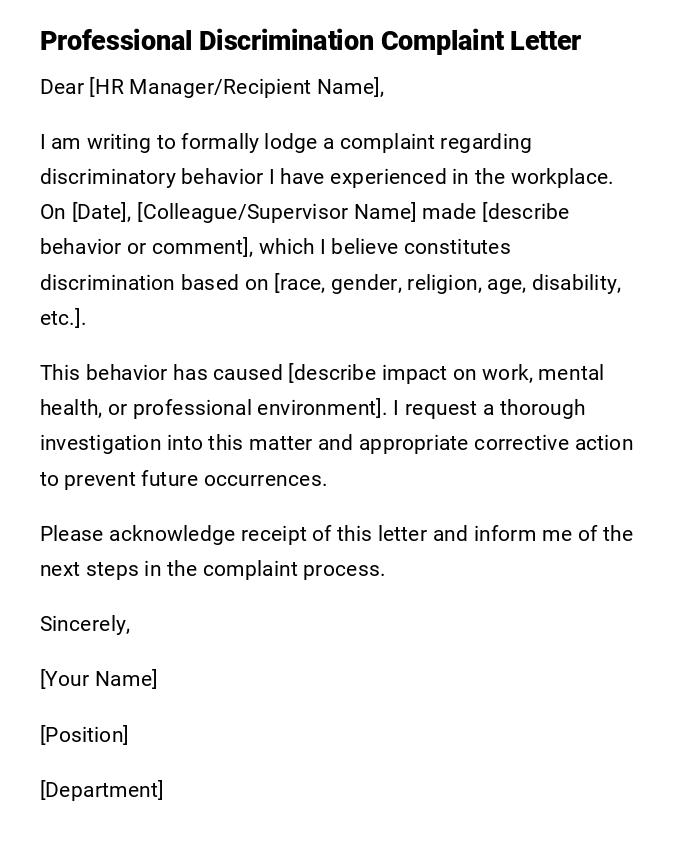
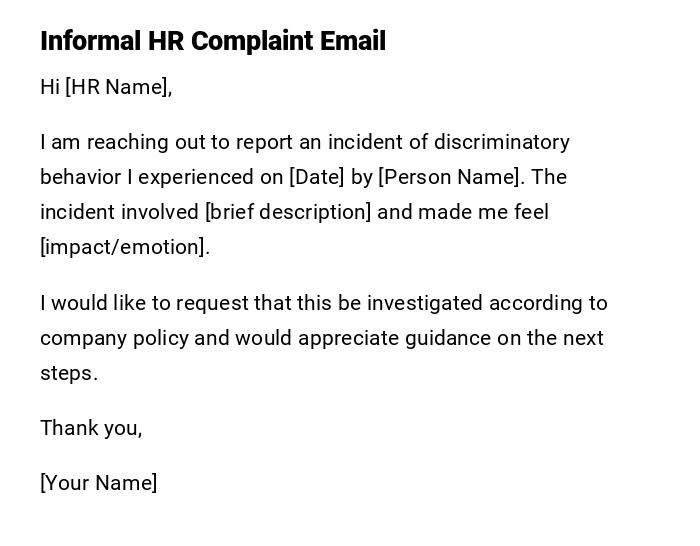
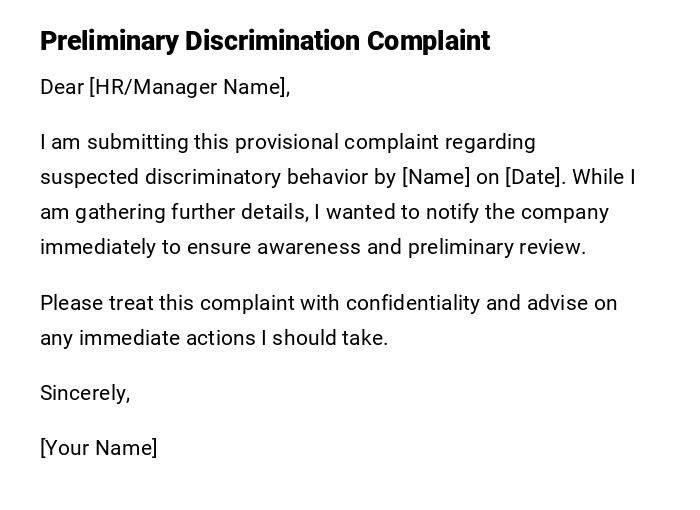


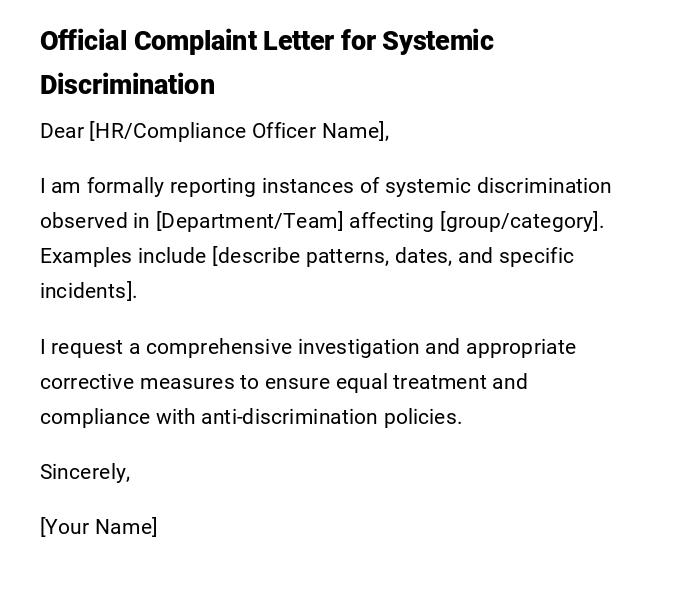
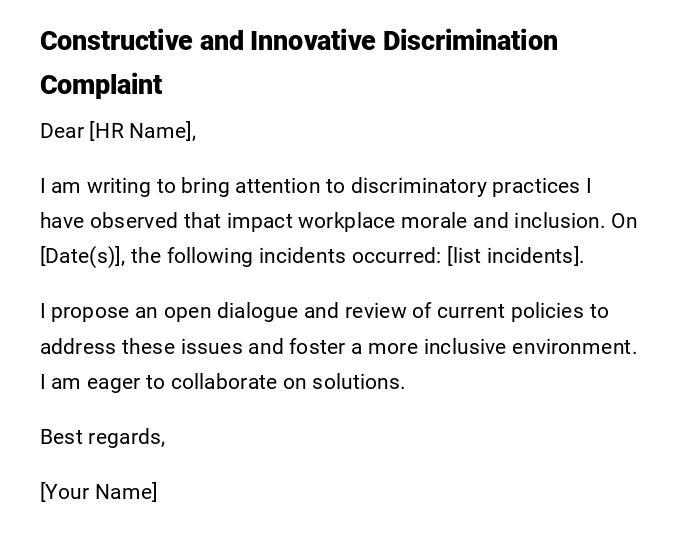

 Download Word Doc
Download Word Doc
 Download PDF
Download PDF